
|   |

|   |
 e-mail: leelakaverivenkat@gmail.com Chakshu - Dance from the perspective of the camera Photos courtesy: Kalpataru Arts May 21, 2021 Looked at from any perspective, the three day virtual festival Chakshu jointly organised by Kalpataru Arts and Kri Foundation, featuring dance viewed from the perspective of the camera lens, was a clear winner not only in terms of the varied range of viewership it attracted from various parts of the world, but also for its animated, highly informative and educative post-film screening discussions involving the best of film makers, scholars, performers and above all, young enthusiasts making a foray into this hitherto unexplored territory. This event conceived by Sangita Chatterjee (whose organisation Kalpataru Arts since its inception in 2013, has promoted various events mostly connected with Kathak, her medium), a lately committed convert to this field of Dance through the Camera, in collaborating with Kri Foundation, had the advantage of a person like Arshiya Sethi, Founder Managing Trustee of the Foundation to moderate the discussions. Arshiya's Danzlenz vertical events over the last two decades have made her an acknowledged world promoter of dance viewed through the camera lens. The handsome Indian participation in this festival was particularly heartening, for it threw up a people who till now, held captive by traditionally oriented live performances, have been compelled by the widespread negativity stemming from Covid restrictions, to look at other opportunities the virtual world throws up. Rather than being judgemental, I admire the young minds in particular for not losing themselves in despondency. Of the Indian entries, the lyrical curtain raiser film 'Aksharakaram' conceived by Jaya Jaitly (founder of Dastakari Haat Samiti whose film 'Akshar' was part of the Crafts Exhibition on calligraphy), was spun round 'akshara' or letter, the starting point of the word, which through its evolution as language is the ultimate connector of this universe. Kalidasa in the verse "vaakarthaa vivasampruktau vaakartha pratipattaye..." sees the word and its meaning, like the oneness of Shiva Parvati, as inseparable. So too, language like the skin of one's body is an inalienable part of one's consciousness. Absorbed into one's inner being, and no matter what form it takes, creativity is internalised sacred energy. Directed by Kalpana Subrahmanyam with dancer/choreographer Justin McCarthy and his students performing minimalistic movements, the camera lens, smoothly establishes calligraphy as an art as much as dance movement and expression. The starting point of all communication is the 'akshara'. Black letters (consonants and vowels) suddenly appearing on the stark white background) above the dancer, flute music, meditation all seamlessly coalesce establishing how all creative activity in the Indian ethos exists in a give and take. Jaya Jaitly, during the question and answer session touched on how society thoughtlessly looked at the craftsman as being below the artist. The man who crafts the musical instrument cannot be less of a creative genius than the musician who plays on it to produce music! Nan Melville's film 'For the Love of Dance' on Nrityagram, brought back poignant memories of Protima Bedi, whose passionate commitment to dance (which she took to rather late in life) led to the establishment of Nrityagram, a dance village, far from the glamour and distractions of city life, where dance as a way of life lives amidst Nature. After Nrityagram's dazzling New York performance in 1997, Nan had met Protima and this film made in 2008, while not new, gives an idea of how dance as a way of life, just is. The eternal crunch with lack of funds has prevented a more recent film by Nan. Some films speak as eloquently even today as when made over ten years ago, like Red Stamp by Benish Mahmood with dancer Sanjukta Wagh (known more as a Kathak dancer, who working in the Trinity School engaged with Contemporary dance too), her improvised convulsive movements in cramped space (impression produced by camera) very successfully denotes the all pervading angst in today's caged and confined world with the pandemic. Taking dance away from the closed auditorium to the wide open spaces, distances the art from the usual choreographed, often egoistic, performative expression. Neha Bhatnagar, young Bharatanatyam dancer, takes one to the forests of Australia in 'Mother' (here it is the King Cobra in the nurturing role guarding her young from danger). Given Neha's love for animals, she finds nature imparting in her a feel of humility - giving her as a Bharatanatyam dancer a very different perspective. Delightfully short, a film from the series 'Boxed' conceived by Anita Ratnam and Chitra Sundaram with Sarveshan's highly inventive contemporary dance movements (also a Kalakshetra trained Bharatanatyam dancer) on the top of the kitchen counter during total lockdown shows improvisation at its best - and in minimal time! 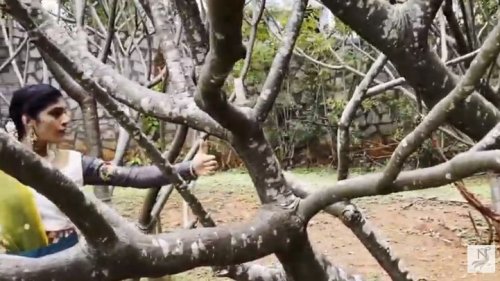 Thiruppavai The same clarity in brevity (even God does not get more than 7 minutes as Anita remarked during the post- filming discussion!) characterised Anita's direction of 'Andal's Garden' series for Narthaki. The sequence chosen from Tiruppavai was on Andal's 24th Pasuram, the Tamil poetry presented through group work in Kathak, sensitively visualised by Madhu Nataraj. Anita's conditions were that Andal's poetry in Tamil be retained in the original, that the outdoors be the venue with dancers not in formal costumes. Singing the glory of Krishna's feet as Vamana or as Govardhanagiridhari holding aloft the mountain on his little finger, or as destroyer of Pootana in the cradle, or as bowman Rama killing Ravana, Madhu's choreography was minimal - self explanatory in just ashankha mudra, or foot placed on another's head, or the pose of shooting an arrow - and while strung to a text, the camera in the mix of Bharatanatyam syllables, music with Tamil words suiting Kathak movement, created eye catching images of the dancers moving amidst nature, with the stark beauty of trees totally bereft of leaves. 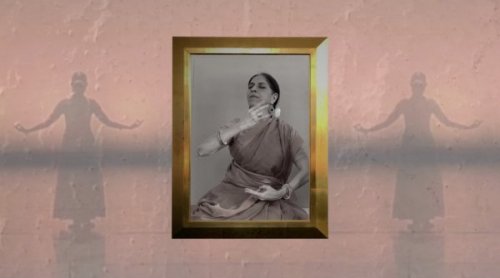 Within from Within 'Within from Within' comprising six short films proves how the very personification of Kathak vigour in performances, dancer Aditi Mangaldas, a world dancer, has begun to look at dance very differently. Far from the finished perfection of stage performances, she is no longer put off by vulnerability of non success in her new look dance films. In a world which has stripped life of any type of assurance or security, thinking afresh about how dance can reflect the present reality has stirred these evocative flashes of having to make the best of a closed world 'Within from Within.' The dancer has experimented with movement angles through photography in which she confesses she is far from proficient. Not succumbing to present emptiness, she has boldly explored possibilities in a blank wall, movement within the claustrophobic space of a closet, and used a shower curtain as backdrop - depending on serendipity for results. For instance, just a face covered with the splayed fingers of one hand, behind bars of a window, speaks powerfully. Knowing Aditi, this marks the start of a new, limitless journey. Spun round haunting images and reverberating sound of music, and scenes from the riverine culture of the Brahmaputra valley, Shilpika Bordoloi's 'Nature of Nescience', the camera angle and lens create an image on the branch of a tree, of some kind of creature, neither man nor animal created with the shadows playing on the entangled limbs of the dancer (After all, the Bhagavata so central to Assamese culture has the Dashavatar images of God taking on forms blending the human and the animal) perhaps alluding to unknown forces, unleashed by man's ignorance (whether through religious forces, or through supposedly progressive planning like dams across the Brahmaputra which China is busily engaged in and which if let loose, through floods would totally submerge islands like Majuli, the heart of Sattiriya culture) further endangering the cultural identity of the North East. Young in experience, Shilpika has a feel for the camera weaving its own story. 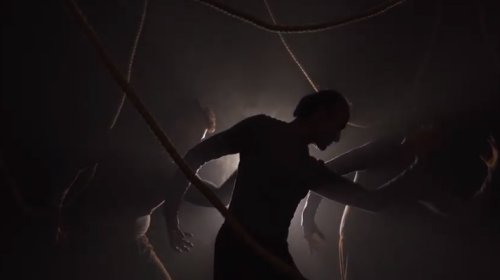 Grapple Contemporary dance by Santosh Nair, founder of Sadhya, is based on his Chhau training. Sponsored by Battery Dance Company some time back, and screened during this festival 'Grapple,' another evocative, well made film choreographed by Santosh Nair, features him with two of his Sadhya trained dancers. Experimenting with light and camera, he mentioned discovering the fact of neither too much brightness not darkness being good for photography. It is the in-between light that works best. Social commentary with a strong political subtext was in Nikita Maheshwary's Home using two characters Sita and Gita, on homelessness, Article 19, lines, Eve Teasing. Living in Minnesota, Ananya Chatterjea is one of the most committed believers in social justice through dance and her choreography is a response to burning issues in society. A lover of live engagement through dance, in the present social climate in which she lives and works, her sense of justice has made her discard entertaining, performance oriented dance, her art used instead for pointing out the imbalances in a society where racism, marginalization, dislocation, homelessness, lack of water are all burning problems. "My thinking is powered by my dancing and my dancing is powered by my critical analysis," she has said in an interview. Her latest work 'Dastak' with Darren Johnson's camera work (working with whom she admits has influenced her aesthetic sensibilities) in four parts - Earth, Water, Fire and Air - is a searing comment on society. The grim 'Fire' sequence with charred wreck piled at the back, where the dance choreography must have been very challenging, vibes with the horror of Floyd's killing (close to where she lives), the racial divisions, the immigrant woes (the water scene with the crushed paper boat - Is it boat in water or water in the boat?) and despite the beauty of nature in the other scenes, the whispering air seems choked - reminding one of the heart rending "I can't breathe" cry of Floyd. Ananya admits that 'normal' no longer works in a world gone awry with the pandemic and other problems. The music of native American psalms, echoes a people forced out of their own homeland. Laden with irony is Sumedha Bhattacharya's short film Jam Upload Down Upload Jam. Through modern devices like custom electronics, modular youth etc, Navarasa representing the entire Universe with emotions, is crushed and locked in the tiny space (the date of the work in 2020 is mentioned too) of a phone, with the dancer herself wielding the phone camera, subverting the gaze of the audience! The high point of the three day festival was for me 'Circling' pointing to the cyclical nature of life, by Douglas Rosenberg (Chair and Professor of Video/Performance/ Installation at the University of Wisconsin), with the famous Sally Gross as dancer. The minimalism in Sally's moves, reflecting rare stillness with a meditative silence, stems as mentioned from her deep involvement with Zionism and Buddhism. In the economy of moves, Douglas' camera, suggesting the circular feel in everything, was an example of how such work could emerge, not from a stage performance, but from within the space of a creative cameraman with equally imaginative editing. Through the eye catching black and white contrast, it was a kind of 'sacred communion' of musicians, dancer and camera, with unexpected images appearing during the process of filming. In the question and answer session, Douglas Rosenberg, (specifically questioned by Sangita on 're-corporealization' mentioned in his book), gave the example of Frankenstein (an imagined unreal body made up of the coming together of different parts, totally unlike the real body) as an example of the unexpected something that a camera can throw up during filming, unlike the usual narrative body used in dance. This playing with unpredictability which creates something on the spot (which dries up the minute it is created and cannot be recreated) is what dance through the camera is all about. 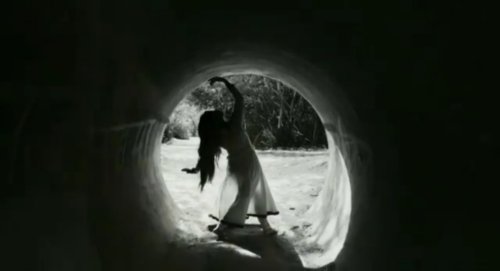 Mirage Of the five films made for the event, Sangita after her first attempt 'Quest' Lockdown diary of a dancer last year, has increasingly familiarised herself with this medium. Filmed by Rahul, Sangita's 'Mirage - A lust for life' builds round that inexplicable pull driving every individual towards that supposed Eldorado, which eludes grasp even as one seems to get near, drawing one into life's tunnel leading to nowhere. Striking photography of the photogenic dancer (in one shot seen in two frames side by side, as a contrast) characterises the film catching Kathak in the outdoors, as also within the narrow spaces of a home with curtains used as props - showing Sangita's ease with changed locations. But with an inward looking theme prompted by beautiful lines of Rumi's poetry heralding each sequence (like why struggle to open doors between us when the entire Universe is a wall), perhaps less of the glamour of accenting on the dancer's face and body, would strengthen the devotional vibes? 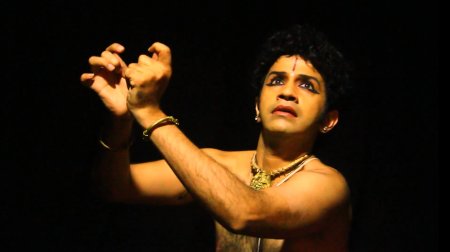 Pavitra Bhat 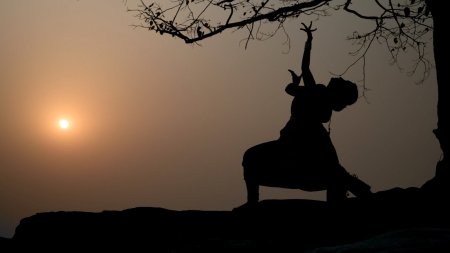 Sakhi he What Douglas mentioned was an excellent eye opener for the young Indian dancers Pavitra Bhat, Anwesha Mahanta, Prachi Saathi, Swapnokalpa Dasgupta, all proven performers in their respective fields. But costumed in full regalia, Pavitra Bhat's "Divine Dews" with Srikanth's dulcet singing was like a stage traditional performance shown on film - like a Doordarshan national programme show. Anwesha's performance built round the traditional sakhatwa in the Nava Vidha Bhakti, showing the role of the sakhi. "Sakhi he... An emovere" introduced through her very erudite commentary and excellent dancing was also a full fledged stage performance filmed. Swapnokalpa's 'Eyeconic tales of love' showing the different types of Nayika in a modern setting had a sense of humour with all the old symbols of letter writing and pining in love, replaced by the laptop and the hand phone. Again with her own commentary, it became a narrative on stage rather than a story created by the camera lens. Prachi Saathi's "Raftar Karo Kaam" on slowing down, apart from Minnu Bakshi's lyrics had a very pertinent message for today to slow down and to watch and experience the beauty of Nature. And the strong message was that we must not miss a bit of this beauty for with nature being damaged so fast, to enjoy a garden blooming may become a sight in the past. 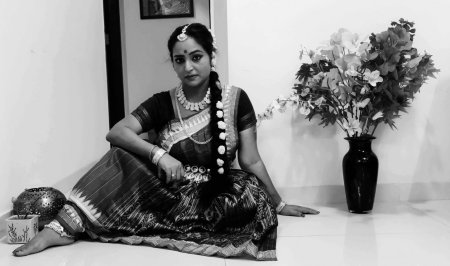 Eyeconic tales of love 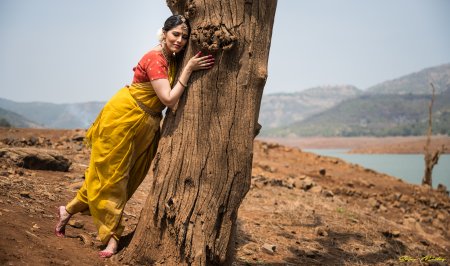 Raftar Karo Kaam Dance film pertains to a separate genre, where the unpredictability of the camera lens following movement through its own eyes, catches images not to be replicated on stage. One lauds the love for poetry and the initiative shown of these young dancers in stepping into totally unexplored waters. Given their intelligence, what they need is more time to familiarise themselves with this new medium. They are all capable of adding a lot to dance as seen by the camera lens. One wishes them the best. Kudos to Kalpataru Arts and Kri Foundation for pulling off an event like Chakshu.  Writing on the dance scene for the last forty years, Leela Venkataraman's incisive comments on performances of all dance forms, participation in dance discussions both in India and abroad, and as a regular contributor to Hindu Friday Review, journals like Sruti and Nartanam, makes her voice respected for its balanced critiquing. She is the author of several books like Indian Classical dance: Tradition in Transition, Classical Dance in India and Indian Classical dance: The Renaissance and Beyond. Post your comments Pl provide your name and email id along with your comment. All appropriate comments posted with name and email id in the blog will also be featured in the site. |